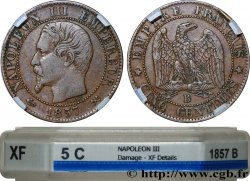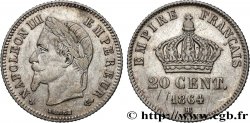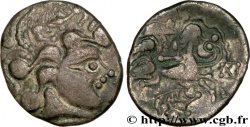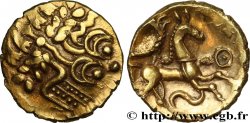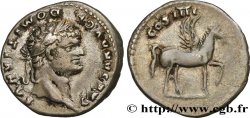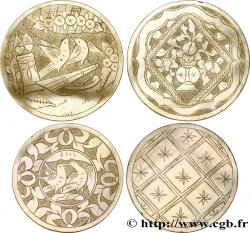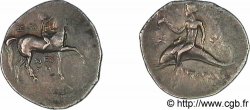Live auction - fme_473766 - SECOND EMPIRE Médaille, Palais de l’Industrie, Vue du pavillon Nord et des Galeries
Чтобы принять участие в торгах, вы должны войти в систему и стать подтвержденным участником аукциона. Войдите, чтобы сделать ставку. Ваш аккаунт будет подтвержден в течение 48 часов. Не ждите до закрытия торгов, чтобы зарегистрироваться.Сделав ставку на данный товар, вы вступаете в юридическое соглашение на покупку выбранного товара и нажатием кнопки «Сделать ставку» подтверждаете принятие вами условий интернет-аукционов cgb.fr.
Ставка может бить сделана только в полном эквиваленте евро. Торги закроются согласно времени, указанному в описании товара, все ставки, сделанные после закрытия торгов, учитываться не будут. Не следует откладывать предложение вашей ставки до последнего момента, так как система может не успеть обработать вашу заявку, и ваша ставка не будет принята. Более детальную информацию вы найдёте здесь: FAQ по интернет-аукционам.
Все ставки победителей подлежат комиссии 18%.
Все ставки победителей подлежат комиссии 18%.
| Оценить : | 250 € |
| Цена : | 150 € |
| Максимальная предлагаемая цена : | 150 € |
| Конец торгов : | 31 July 2018 18:10:59 |
| Участников : | 1 Участников |
Тип Médaille, Palais de l’Industrie, Vue du pavillon Nord et des Galeries
Дата: 1855
Монетный двор / Город: Paris
Металл: copper
Диаметр: 67,5 mm
Ориентация осей монеты: 12 h.
Вес: 125 g.
Век: Lisse
Пуансон: sans poinçon
Комментарии о состоянии
Patine marron. Présence de coups
Ссылки в каталоге: :
Лицевая сторона
Аверс: легенда: PALAIS DE L’INDUSTRIE, (LÉGENDE SUPÉRIEURE) ; PAVILLON DU NORD / GERVAIS ET C EDIT..
Аверс: описание: Vue du Pavillon nord du Palais de l’Industrie; signé : J. WIENER F..
Обратная сторона
Реверс: легенда: PALAIS DE L’INDUSTRIE / VUE DES GALERIES / GERVAIS ET CIE EDIT.
Реверс: Описание: Vue intérieure des galeries; signé : JACQUES WIENER FEC. et MANGUIN DEL.
Комментарий
L’exposition universelle fut décrétée pour le 15 mai 1855 pour témoigner au monde entier de la prospérité de la France, suite à l’exemple de l’Angleterre en 1851. Napoléon III inaugura cette première exposition universelle française en déclarant : “j’ouvre avec bonheur ce temple de la paix qui convie tous les peuples à la concorde”.
Le palais de l’industrie étonna par sa construction métallique et la hardiesse de la nef centrale haute de 35 mètres. Construit de 1853 à 1855, sur les plants de l’architecte Jean-Marie VIel (1797-1863), il forme un parallélogramme de fonte et de verre à deux étages, dont les façades principales ont 252 mètres de long, et les façades latérales 108 mètres. Il est composé d’un pavillon central et de pavillons d’angle. L’entrée principale se compose d’une immense arcade, flanquée de chaque côté de colonnes corinthiennes et surmontées d’une attique que décorent un bas-relief.
A l’intérieur, la nef principale (192 mètres de long, 48 de large et 35 de haut) est entourée au rez-de-chaussée d’une triple galerie formée par quatre rangées de colonnes de fonte supportant une galerie supérieure. Les voûtes, en verre dépoli, sont supportées par der fermes en fonte de fer.
Le palais subsistera jusqu’en 1900 pour ensuite être démoli et remplacé par les Petit et Grand Palais actuels construits pour l’Exposition Universelle de Paris en 1900.
Source : Médailles de Napoléon III, Hess Divo
Vous pouvez retrouver une vue du palais sur ce lien : http://www.carnavalet.paris.fr/fr/collections/vue-d-une-allee-transversale-du-palais-de-l-industrie.
The Universal Exhibition was decreed for May 15, 1855 to demonstrate to the whole world the prosperity of France, following the example of England in 1851.. Napoleon III inaugurated this first French universal exhibition by declaring: “I open with joy this temple of peace which invites all peoples to harmony.”.
The Palace of Industry surprised by its metal construction and the boldness of the 35-meter high central nave.. Built from 1853 to 1855, on the plans of the architect Jean-Marie VIel (1797-1863), it forms a parallelogram of cast iron and glass on two floors, the main facades of which are 252 meters long, and the side facades 108 meters. It is composed of a central pavilion and corner pavilions. The main entrance consists of an immense arcade, flanked on each side by Corinthian columns and surmounted by an attic decorated with a bas-relief.
Inside, the main nave (192 meters long, 48 wide and 35 high) is surrounded on the ground floor by a triple gallery formed by four rows of cast iron columns supporting an upper gallery. The vaults, made of frosted glass, are supported by cast iron trusses..
The palace remained until 1900, when it was demolished and replaced by the current Petit and Grand Palais, built for the Universal Exhibition in Paris in 1900..
Source: Medals of Napoleon III, Hess Divo You can find a view of the palace on this link: http://www. carnival. Paris. fr/fr/collections/view-of-a-cross-aisle-of-the-palace-of-industry
Le palais de l’industrie étonna par sa construction métallique et la hardiesse de la nef centrale haute de 35 mètres. Construit de 1853 à 1855, sur les plants de l’architecte Jean-Marie VIel (1797-1863), il forme un parallélogramme de fonte et de verre à deux étages, dont les façades principales ont 252 mètres de long, et les façades latérales 108 mètres. Il est composé d’un pavillon central et de pavillons d’angle. L’entrée principale se compose d’une immense arcade, flanquée de chaque côté de colonnes corinthiennes et surmontées d’une attique que décorent un bas-relief.
A l’intérieur, la nef principale (192 mètres de long, 48 de large et 35 de haut) est entourée au rez-de-chaussée d’une triple galerie formée par quatre rangées de colonnes de fonte supportant une galerie supérieure. Les voûtes, en verre dépoli, sont supportées par der fermes en fonte de fer.
Le palais subsistera jusqu’en 1900 pour ensuite être démoli et remplacé par les Petit et Grand Palais actuels construits pour l’Exposition Universelle de Paris en 1900.
Source : Médailles de Napoléon III, Hess Divo
Vous pouvez retrouver une vue du palais sur ce lien : http://www.carnavalet.paris.fr/fr/collections/vue-d-une-allee-transversale-du-palais-de-l-industrie.
The Universal Exhibition was decreed for May 15, 1855 to demonstrate to the whole world the prosperity of France, following the example of England in 1851.. Napoleon III inaugurated this first French universal exhibition by declaring: “I open with joy this temple of peace which invites all peoples to harmony.”.
The Palace of Industry surprised by its metal construction and the boldness of the 35-meter high central nave.. Built from 1853 to 1855, on the plans of the architect Jean-Marie VIel (1797-1863), it forms a parallelogram of cast iron and glass on two floors, the main facades of which are 252 meters long, and the side facades 108 meters. It is composed of a central pavilion and corner pavilions. The main entrance consists of an immense arcade, flanked on each side by Corinthian columns and surmounted by an attic decorated with a bas-relief.
Inside, the main nave (192 meters long, 48 wide and 35 high) is surrounded on the ground floor by a triple gallery formed by four rows of cast iron columns supporting an upper gallery. The vaults, made of frosted glass, are supported by cast iron trusses..
The palace remained until 1900, when it was demolished and replaced by the current Petit and Grand Palais, built for the Universal Exhibition in Paris in 1900..
Source: Medals of Napoleon III, Hess Divo You can find a view of the palace on this link: http://www. carnival. Paris. fr/fr/collections/view-of-a-cross-aisle-of-the-palace-of-industry







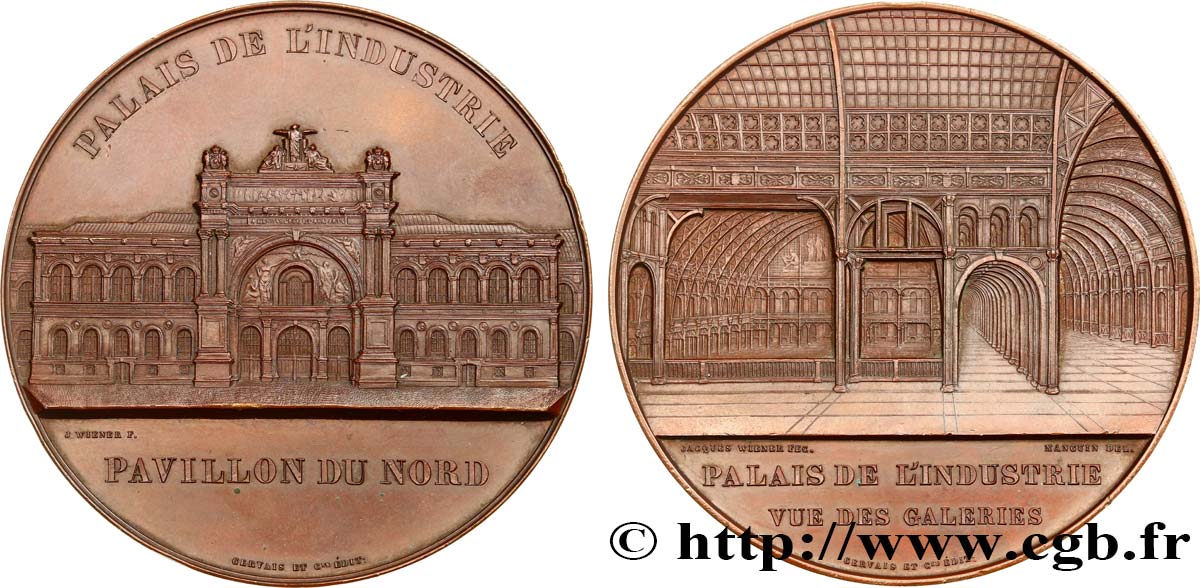
 Cообщить об ошибке
Cообщить об ошибке Распечатать страницу
Распечатать страницу Отправить мой выбор
Отправить мой выбор Задать вопрос
Задать вопрос Consign / sell
Consign / sell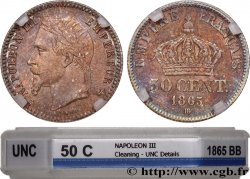
 Информация
Информация
